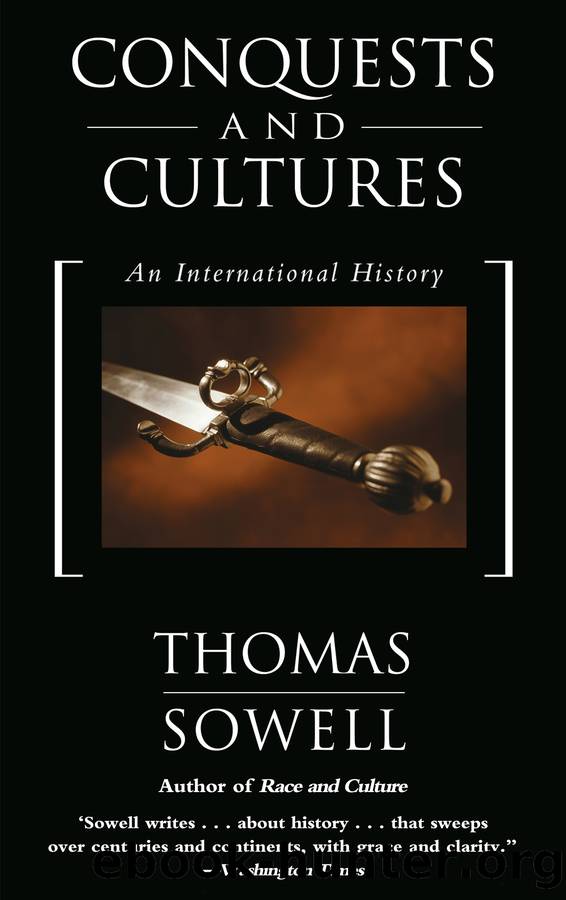Conquests and Cultures : An International History (9781541601383) by Sowell Thomas

Author:Sowell, Thomas [SOWELL, THOMAS]
Language: eng
Format: epub
Publisher: Hachette Book Group USA
Published: 2021-08-10T00:00:00+00:00
Central Asians
The peoples most different from the dominant Slavs of the Russian Empire and the Soviet Union have been the peoples of Central Asia. These differences have been racial, religious, linguistic, demographic, geographic, and historic.
The vast reaches of Central Asia exceed in size all of Western Europe, but the Turkic, historically nomadic, and predominantly Moslem peoples of Central Asia are much more thinly spread over arid lands unable to support the population densities of Europe. Altogether, however, the population of Central Asia has been quite largeâ49 million people in 1989 or about one-sixth of the total population of the Soviet Union.310 These 49 million people included about 33 million indigenous Central Asians,311 with the remainder being primarily Russians and others who migrated in large numbers into Central Asia over the years, as well as Germans, Tatars, and others forcibly relocated there during the Second World War, in order to forestall their collaboration with the invading German-led Axis armies. One measure of the demographic impact of Russian colonization is that Kazakhs fell from 91 percent of the population of Khazakhstan in the middle of the nineteenth century to 57 percent in 1926 and to a low of 29 percent in 1962, before rebounding to about 40 percent by 1989, on the eve of the dissolution of the Soviet Union. In some years, under both the czars and the Communists, the Kazakh population declined absolutely,312 as Russians took over some of their best land and imposed policies disrupting the indigenous way of life.
Once of enormous importance in centuries past, when the Silk Road went through Central Asia to connect Europe and China in trade, or when Genghis Khan created the worldâs greatest land empire in the heart of the Eurasian land mass, this region became in later centuries an economic, military, and political backwater. The discovery of sea routes between Europe and Asia made the Silk Road no longer the prime trade route, since waterborne transport was so much cheaper than land transport, even when the water routes went around the African continent on the way to India and China, before the Suez Canal was built. Suez and industrialization then left Central Asia on the periphery of world developments.
Militarily, the progress of gunpowder weapons in general and cannons in particular put an end to centuries of dominance by warriors charging on horseback, such as those who came out of Central Asia in vast hordes to conquer and strike terror among the peoples of the Far East, the Middle East, and Eastern Europe. Once conquerors of China and overlords of Russia, the peoples of Central Asia were ultimately reduced to becoming the conquered subjects first of the Chinese and then of the Russians. By the nineteenth century, czarist Russia controlled Central Asia and in the 1920s the Communists under Stalin began to carve it up into the separate republics of Kazakhstan, Turmenistan, Uzbekistan, Tajikistan, and Kyrgyzstan. Despite sweeping changes imposed on Central Asia from Moscow under the Communists, there was no great knowledge or understanding of the indigenous peoples of Central Asia.
Download
This site does not store any files on its server. We only index and link to content provided by other sites. Please contact the content providers to delete copyright contents if any and email us, we'll remove relevant links or contents immediately.
Cecilia; Or, Memoirs of an Heiress — Volume 1 by Fanny Burney(31351)
Cecilia; Or, Memoirs of an Heiress — Volume 3 by Fanny Burney(30949)
Cecilia; Or, Memoirs of an Heiress — Volume 2 by Fanny Burney(30907)
The Great Music City by Andrea Baker(21572)
We're Going to Need More Wine by Gabrielle Union(18086)
Bombshells: Glamour Girls of a Lifetime by Sullivan Steve(13119)
Pimp by Iceberg Slim(12946)
All the Missing Girls by Megan Miranda(12775)
Fifty Shades Freed by E L James(12463)
Talking to Strangers by Malcolm Gladwell(11907)
Norse Mythology by Gaiman Neil(11901)
Crazy Rich Asians by Kevin Kwan(8372)
Mindhunter: Inside the FBI's Elite Serial Crime Unit by John E. Douglas & Mark Olshaker(7850)
The Lost Art of Listening by Michael P. Nichols(6483)
Enlightenment Now: The Case for Reason, Science, Humanism, and Progress by Steven Pinker(6414)
Bad Blood by John Carreyrou(5782)
The Four Agreements by Don Miguel Ruiz(5532)
Weapons of Math Destruction by Cathy O'Neil(5046)
We Need to Talk by Celeste Headlee(4881)
